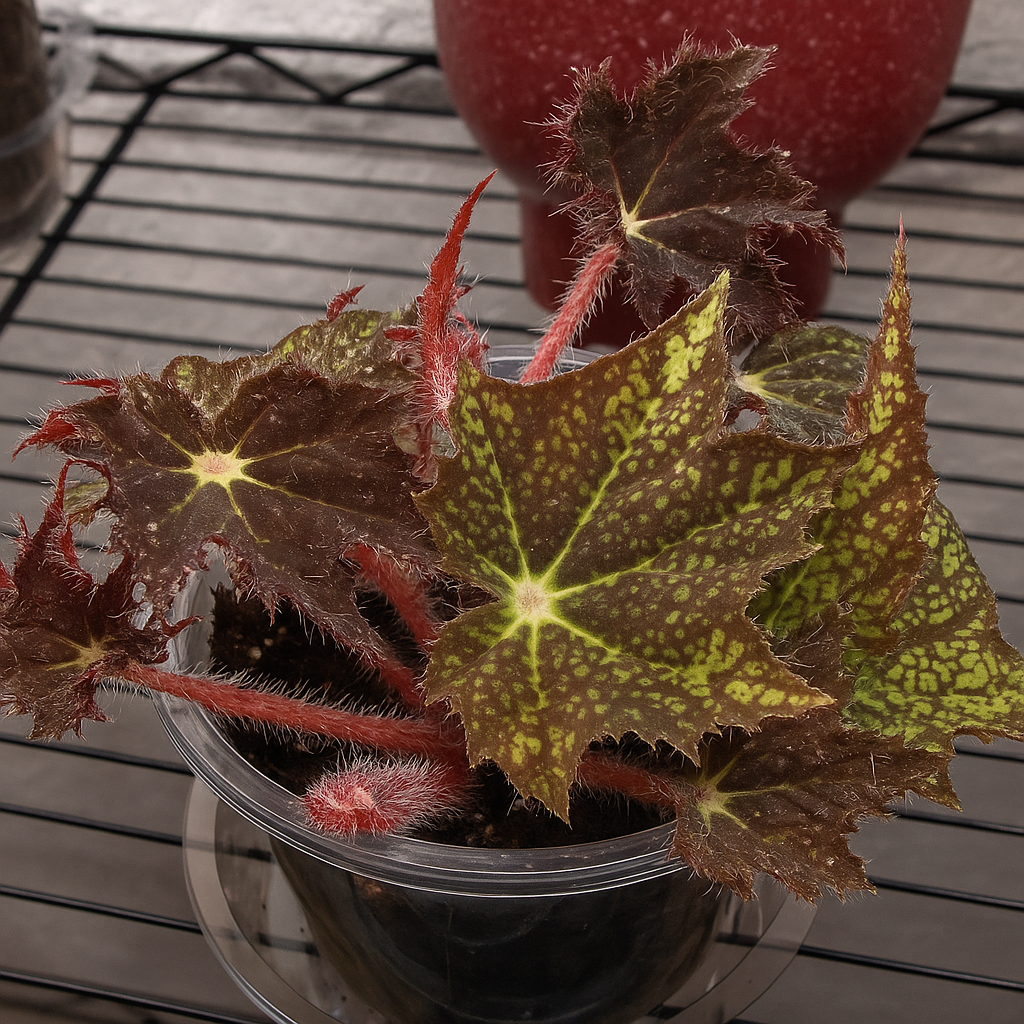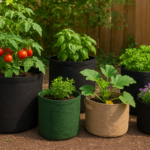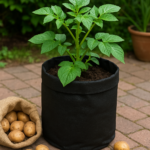Begonia Heracleifolia is one of those striking plants that instantly grabs attention, whether it’s in a garden or sitting on a windowsill. Known for its vibrant foliage and unique growth pattern, it has become a favorite among plant lovers, interior decorators, and even botanical collectors. Unlike ordinary begonias, Begonia Heracleifolia has a character of its own—charming, wild, and slightly mystical. This plant belongs to the large Begoniaceae family and offers both visual beauty and low-maintenance growth, making it ideal for beginners and seasoned gardeners alike.
In this article, we’ll take a deep dive into everything you need to know about Begonia Heracleifolia—from its origins and growing tips to propagation, care, and display ideas. Let’s explore why this plant deserves a prime spot in your garden or home.
About Begonia Heracleifolia
Begonia Heracleifolia has a fascinating origin that traces back to the lush, mountainous regions of Central America, particularly Mexico. It thrives in tropical and subtropical environments where humidity is abundant and temperatures rarely fall to freezing. In its native habitat, it often grows under the canopy of taller trees, thriving in the dappled sunlight and rich organic soil. This natural setting provides key insights into how you should care for it in your own space.
The species was first described scientifically in the 19th century, and since then, it has grown in popularity among horticulturists and plant enthusiasts worldwide. The name “Heracleifolia” is derived from Greek mythology, referencing Heracles (or Hercules), suggesting that the leaves are strong, bold, and deeply cut—just like the hero’s strength. This adds a unique charm and mystique to the plant’s reputation.
Botanical Classification and Family Background
Botanically speaking, Begonia Heracleifolia belongs to the vast Begoniaceae family, which includes over 1,800 species of flowering plants. Within this group, it’s classified as a rhizomatous begonia, which means it grows from thick, fleshy stems called rhizomes. These rhizomes store water and nutrients, allowing the plant to survive short dry spells—another trait that makes it a great houseplant.
Its genus, Begonia, is named after Michel Bégon, a French colonial governor and plant collector who lived during the 17th century. These plants have been collected and cultivated since then for their striking foliage, unique flower structures, and adaptability to different environments. Among begonias, Heracleifolia stands out due to its bold leaf patterns and strong architectural structure.
Key Physical Features and Appearance
Begonia Heracleifolia is a plant that commands attention, thanks to its striking and artistic features. One of the most notable aspects of the plant is its maple-like leaves. These leaves are typically large, deeply lobed, and have a rich, dark green color that sometimes features bronze or purplish undertones. The foliage often looks hand-painted, with intricate veining that adds texture and depth to its appearance.
The plant usually grows low to the ground but spreads horizontally through its rhizomes, giving it a bushy, full look. Its stems are thick and somewhat fuzzy, a trait common to rhizomatous begonias. The leaves grow in a spiral pattern, creating a visually dynamic rosette that looks almost floral even when the plant isn’t blooming.
Leaf Structure and Texture
The leaves of Begonia Heracleifolia are nothing short of spectacular. Shaped like a maple leaf, each one features multiple pointed lobes that radiate out from a central point. The size of the leaves can vary depending on growing conditions, but they often reach up to 6–8 inches in diameter, creating a lush and full appearance.
Texture-wise, the leaves are slightly rough or hairy, especially on the undersides, which is a natural adaptation to their tropical origin. This fuzz helps to retain moisture and protects the plant from pests and intense sun exposure. The surface of the leaf is often glossy and may even shimmer slightly under direct light, which enhances its decorative appeal.
Coloration adds another layer of interest. Most Begonia Heracleifolia plants sport deep green leaves with bronze, silver, or even reddish highlights along the veins or edges. In some cultivars or with certain care conditions, the leaf colors may deepen or become more variegated over time.
Flowering and Color Variations

While the dramatic foliage of Begonia Heracleifolia steals most of the attention, its flowers add a soft and delightful contrast. These flowers typically appear during the warmer months, especially in spring and summer, when the plant is in active growth. The blossoms are relatively small compared to the size of the leaves, but they stand out due to their pale hues and delicate form. Usually, you’ll see them in gentle shades of white, blush pink, or very light lavender, rising above the foliage on thin stems.
Unlike many ornamental plants that bloom in a loud, showy fashion, Begonia Heracleifolia takes a subtler approach. Its flowers resemble small bells or stars, and they cluster in loose arrangements that sway slightly in the breeze. This gentle movement adds a touch of whimsy and elegance, especially when placed in a hanging pot or near a window where natural light can illuminate them.
Best Climate and Growing Zones
Begonia Heracleifolia is native to the warm and humid climates of Central America, which means it thrives best in USDA hardiness zones 9 to 11. If you live in a region where winter temperatures rarely drop below 20°F (-6°C), you can likely grow this beauty outdoors year-round. However, in cooler areas, it’s best to grow it in pots that can be moved inside during colder months or treat it as a seasonal plant.
This begonia loves warmth and consistent humidity. Ideal daytime temperatures range from 65°F to 80°F (18°C to 27°C), with night temperatures not falling below 55°F (13°C). If your area experiences dry winters or harsh sun, consider placing it indoors near a humidifier or grouping it with other tropical plants to maintain a microclimate.
Indoor growers should avoid placing the plant near heating vents or cold drafts, which can cause stress. It also appreciates good air circulation, so crowded, stagnant spots are a no-go.
Soil Preferences and Requirements
Like many tropical plants, Begonia Heracleifolia thrives in rich, well-draining soil. It prefers a soil mixture that retains fmoisture but doesn’t become soggy—think of the damp, slightly crumbly forest floor where it originates. A good potting mix for this plant should combine components like peat moss, perlite, and organic compost to ensure proper drainage and airflow.
Avoid using regular garden soil straight from the backyard. It’s often too dense and may contain pests or pathogens that the begonia is sensitive to. Instead, opt for a store-bought mix designed for indoor tropical plants or make your own blend using equal parts peat moss, perlite, and a bit of orchid bark or leaf mold. This combination helps the roots breathe and prevents root rot.
How to Plant Begonia Heracleifolia
Planting Begonia Heracleifolia correctly from the start is key to its long-term success. Whether you’re starting from a nursery pot or propagating your own cutting, the right planting method ensures your begonia gets off to a strong, healthy beginning. Start by choosing a container with adequate drainage holes. This plant doesn’t like to sit in water, and excess moisture can quickly lead to root rot.
Next, prepare a loose, well-aerated potting mix—something that retains moisture but drains well, as covered in the previous section. Fill the container about three-quarters full, gently loosen the root ball of the begonia, and position it so that the top of the root structure sits just below the container rim. Backfill with soil, pressing it down lightly to secure the plant but not so firmly that you compact the roots.
Water thoroughly after planting, allowing the soil to settle. If you’re planting in a garden bed in a suitable climate zone, pick a shaded or partially shaded spot and amend the soil similarly to how you would for a potted plant. Avoid planting too deeply, as this can suffocate the rhizomes..
Light and Watering Needs
Begonia Heracleifolia is a shade-loving plant that thrives best in bright, indirect sunlight. Direct sunlight can scorch its beautiful leaves, leaving brown spots or faded coloring. Think of it like a forest-floor dweller—it enjoys the filtered light that passes through taller trees. If grown indoors, placing it near an east or north-facing window is ideal. For outdoor growing, a partially shaded patio or beneath a taller plant works wonders.
When it comes to watering, consistency is key. The soil should remain evenly moist, not soggy. Overwatering is one of the most common mistakes with begonias. Wait until the top inch of soil feels dry before watering again. In winter, reduce watering frequency, as the plant goes into a slower growth phase.
Fertilizer and Feeding Tips
To keep Begonia Heracleifolia thriving, a balanced feeding routine is essential. While it’s not a heavy feeder, occasional fertilization boosts its leaf color and flower production. During the active growing season—spring to early autumn—apply a diluted, water-soluble fertilizer every 2 to 4 weeks. A balanced 10-10-10 or 20-20-20 formula works well.
Always water the plant before applying fertilizer to avoid burning the roots. If you notice brown leaf tips or a white crust on the soil surface, that’s a sign of over-fertilizing. In such cases, flush the soil with water and pause feedings for a few weeks.
Avoid fertilizing in winter when the plant is semi-dormant. During this time, overfeeding can do more harm than good. Organic alternatives like compost tea or fish emulsion can also be used for those preferring a natural approach.
Common Pests
Even though Begonia Heracleifolia is relatively resilient, it can occasionally attract unwanted guests. The most common pests include aphids, spider mites, mealybugs, and fungus gnats. These pests feed on plant sap, weaken the leaves, and may even spread diseases.
Regular inspection is key. Check under leaves, around stems, and at the base of the plant weekly. If pests are spotted early, you can often eliminate them with a mild insecticidal soap spray or by wiping leaves with a damp cloth dipped in diluted neem oil.
How to Prevent Them
To prevent pests, avoid overwatering and ensure good air circulation. Soggy soil and stagnant air are perfect breeding grounds for insects. Quarantine any new plant before introducing it to your collection, as they might bring hidden pests with them.
Diseases and How to Treat Them
Begonia Heracleifolia, like many tropical plants, is susceptible to several fungal and bacterial diseases, especially when grown in humid environments with poor air circulation. The most common issues include powdery mildew, botrytis (gray mold), root rot, and bacterial leaf spot.
Powdery mildew shows up as a white, powdery coating on leaves and stems. Botrytis appears as gray fuzz, especially in areas where leaves overlap and stay damp. Bacterial leaf spot presents as dark, watery spots that eventually cause leaf drop.
Root rot is perhaps the most dangerous, as it affects the plant below the surface. It’s usually caused by overwatering and poorly draining soil. You’ll know it’s happening when the plant wilts even though the soil is moist, or if the roots appear black and mushy upon inspection.
Pruning and Maintenance Guide

Regular pruning keeps Begonia Heracleifolia healthy, promotes bushier growth, and prevents legginess. Pruning isn’t difficult, but timing and technique matter. The best time to prune is early spring, just as the plant begins its active growth phase. However, you can remove dead or damaged leaves anytime.
Use clean, sterilized pruning shears or scissors to cut back long, leggy stems just above a leaf node (where a leaf joins the stem). This encourages the plant to branch out, making it fuller and more compact. Remove any yellowing or browning leaves, which could harbor pests or diseases.
Aside from pruning, regular maintenance includes cleaning the leaves with a damp cloth to remove dust, checking for pests weekly, and rotating the pot to encourage even growth. If your plant becomes too root-bound, repotting every 1–2 years is necessary.
Propagation Methods
Propagating Begonia Heracleifolia is not only easy but also a rewarding way to grow your collection or share with friends. The most common methods include leaf cuttings, stem cuttings, and division. Each method has its own process, but they all aim to create a new plant from an existing one.
For stem cuttings, select a healthy, non-flowering stem with at least 1–2 nodes. Cut just below a node and remove any lower leaves. Dip the cut end in rooting hormone (optional but recommended), and place it in moist soil or water. If using water, wait until roots develop before transplanting.
Leaf cuttings work similarly: cut a healthy leaf and place it flat against moist soil, pressing it down lightly. New plantlets often sprout along the leaf veins. This method takes longer but is fascinating to watch.
Division is ideal during repotting. Gently separate the root ball into sections, ensuring each division has both roots and stems. Plant them in separate containers and care for them as usual.
Repotting Guide

Repotting Begonia Heracleifolia is essential to ensure healthy growth, provide fresh nutrients, and avoid root-bound stress. Typically, this plant needs to be repotted every 1–2 years, preferably in early spring before the new growing season begins. If you notice roots coming out of the drainage holes or the soil drying too quickly, it’s time to upgrade the pot.
Choose a container 1–2 inches larger in diameter than the current one. The new pot should have proper drainage holes to prevent waterlogging. Use a well-draining potting mix, preferably one designed for tropical plants or a blend of peat moss, perlite, and compost.
Seasonal Care Tips
Caring for Begonia Heracleifolia requires subtle changes as the seasons shift. Understanding how your plant reacts to spring, summer, autumn, and winter will help it thrive year-round.
Spring and Summer are the peak growing months. Increase watering frequency and start feeding the plant with a diluted fertilizer every 2–4 weeks. This is also the ideal time for pruning, propagating, and repotting. Ensure it gets enough bright, indirect sunlight and good air circulation.
In autumn, as temperatures start to cool, gradually reduce watering and stop fertilizing by the end of the season. The plant begins to slow its growth and prepares for dormancy.
During winter, the plant’s metabolism slows significantly. Only water when the top 2 inches of soil are dry, and avoid feeding altogether. Keep it away from cold drafts, and ensure indoor temperatures don’t fall below 55°F (13°C). A humidifier can help maintain moisture levels in heated rooms.
Adjusting your care based on the seasons mimics its natural tropical environment and keeps your plant strong and resilient.
Conclusion
Begonia Heracleifolia is a stunning foliage plant that brings bold beauty to any indoor or shaded garden space. With its uniquely textured leaves, subtle flowers, and easygoing care routine, it’s perfect for beginners and collectors alike. Whether grown in containers, hanging baskets, or garden beds in the right climate, this plant rewards attention with striking growth. Just provide bright indirect light, moderate watering, and good air circulation to keep it thriving. From propagation to pruning, it’s a joy to grow. If you’re looking to add tropical drama and charm to your space, Begonia Heracleifolia is a must-have plant.
FAQs
1. Is Begonia Heracleifolia safe for pets?
No, like many begonias, it can be toxic to cats and dogs if ingested. Keep it out of reach of pets.
2. Can Begonia Heracleifolia grow in low light?
It prefers bright, indirect light. While it can tolerate low light, growth may be slower and leggier.
3. How often should I repot it?
Every 1–2 years or when the roots outgrow the pot. Spring is the best time for repotting.
4. Why are my leaves turning yellow?
Common causes include overwatering, poor drainage, or low humidity. Check the soil and adjust care.
5. Can it grow outdoors year-round?
Only in USDA zones 9–11. In cooler climates, grow it in pots and bring indoors during winter.







